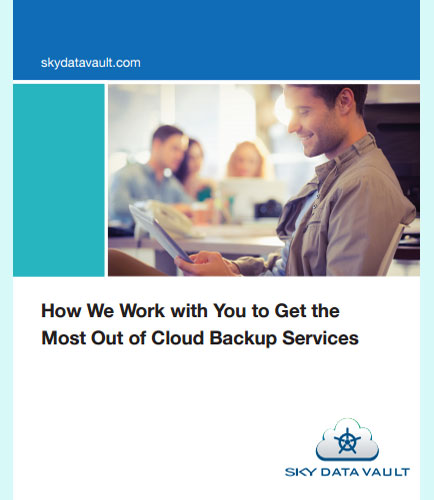
PROCESSING. PLEASE WAIT...



White Paper: Sky Data Vault
Having a disaster recovery plan and also cloud backup services are absolutely necessary for a business to keep its data safe and secure.
With cloud backup and disaster recovery solutions that will allow the business to remain operational during and after any disaster while minimizing the impact of unplanned events and helping them recover as quickly as possible.
This whitepaper provides insights on how to get the most out of cloud backup services.
How do you choose the right Disaster Recovery as a Service (DRaaS) partner to provide the best cloud backup and protection services in the market?
Multiple Disaster Recovery solutions to help the clients succeed and survive through any disaster, which can be damaging to a business
Portfolio of solutions offered to accommodate your clients more efficient way to deliver business critical backup and recovery solutions
The genesis of Sky Data Vault (SDV) traces back to 2013, when the founders, seasoned in managed services, IT support, and telecom marketplaces, recognized the surging adoption of cloud services and demand for affordable, cloud-enabled DR solutions. “We all think of fire, flood, and long term power outage when we hear DRaaS. The reality is human error, hardware failure, and malware are far more common than environmental issues. We felt if we simplified the service for the customer, eliminated upfront hardware costs, and went to market with a monthly service fee, DRaaS would be more accessible for organizations to mitigate risk in all areas of their business,” begins Michael Thompson, Founder, Sky Data Vault. Sky Data Vault’s state-of-the-art Disaster Recovery solutions portfolio includes Direct to Cloud (D2C) Back Up, Hybrid DRaaS, and Direct to Cloud (D2C) DRaaS to give organizations options based on their business objectives. D2C Back Up offers protection and recovery services for important files and folders by encrypting the backups and storing them in the secure SDV Cloud.
By: IDC
ERP systems are the technology backbone of the modern business, and as such, the process of matching the "right" system to specific business needs is extremely critical. Most companies spend quite a bit of scarce resources (time and money) on defining the business requirements and then evaluating the potential systems for a close functional fit and for the potential up-front (implementation and license) costs.
By: Software AG
Digital business transformation is based on an IT architecture transformation with a roadmap for digital capability implementation. Based on the software platforms, digital companies create enhanced or totally new business models which offer completely new digital customer experiences. Established companies are building up software know-how and are acquiring software companies to accelerate their digital transformation by injecting software innovation capabilities into their core business areas. This whitepaper helps to understand what makes today’s digital challengers attractive to customers and consumers, as it highlights their core competencies and differentiators based on their digital software-based technology. Key takeaways from this whitepaper: Digital challengers separate companies from their customers Implementing digital capabilities for digital use cases Digital companies have a micro services-oriented, scalable IT architecture


 2025 All Rights Reserved | by: www.ciowhitepapersreview.com
2025 All Rights Reserved | by: www.ciowhitepapersreview.com